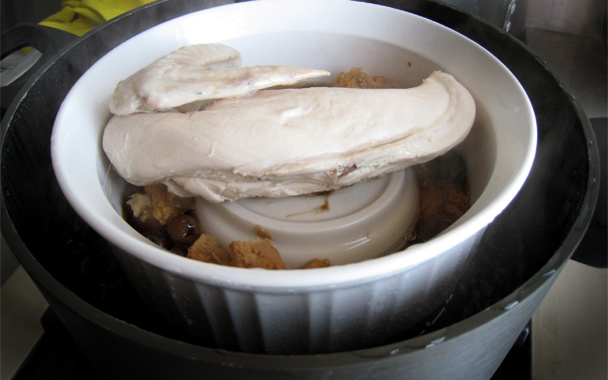Last week was the first in almost a year and a half that I didn’t post something on gourmet.com, and I’m bummed out about it. I wanted to, but I was laid up in bed after having a run-in with a pair of men with scalpels. Apparently I let them do this to me, but I think there were drugs involved.
And while I’ve been lying around at home playing the little-loved game called “Wanna see my scar?” my dear mother has flown up to take care of me. Wonderfully / embarrassingly, she’s cooking for me as I write this. “But Mom, I’m a grown man! I can order delivery just like anyone else convalescing in New York!”
“Ai ya!” she retorts. “Restaurant food is not healthy. And they won’t make this for you.” She’s waving another bowl under my nose, the latest in a long line of bowls of fragrant, chickeny liquid.
“Oh,” you’re thinking. “Chinese mothers make Jewish penicillin, too.”
Yes…only it’s not quite like that. My mother, whose cooking is characterized by (metaphoric) sweetness, sagacity, and superstition, is doing something that I’ve never seen before. She’s not making chicken soup, she’s making chicken essence. By which I mean that she’s essentially steaming chicken in a closed bowl and catching the juice that comes out of the chicken and pouring that into a bowl. She says that it’s more nourishing that way, without any added liquid to dilute the essence. What comes out isn’t a whole lot, but it’s incredibly deep, almost murky with flavor. And while I haven’t yet figured out what to do with it culinarily, its intensity is so remarkable it’s worth making and playing with.
The technique she’s using is what the Cantonese call “dun,” which is usually translated as “double boiled,” meaning not that it’s boiled twice, but that it’s steamed in a crock that’s partially immersed in water, much as you might use a bain marie to keep the heat in an oven pan consistent and gentle.
She has a big pot with a rack at the bottom. On the rack she sets a big bowl, with a small, flat ramekin upside down in it. On top of the ramekin she sets a skinless half chicken or a hunk of lean pork shoulder. Around the ramekin she’s got a bunch of Chinese medicinals—ginseng and the like—but you can skip these or use a few aromatics of your choice. Then she covers the whole thing with plastic wrap, fills the big pot with enough water to come up the sides of the internal bowl by about an inch, and covers it all with the lid. Then she gets the water boiling, turns it down to a healthy simmer, and lets it steam for about two hours.
As the heat builds inside the bowl and the chicken starts to cook, it sweats off its juices, which run down the ramekin’s sides where they gently infuse with whatever’s down there (or nothing, if you want to keep it pure). After two hours, the bird is pretty well drained, and when you kill the heat the liquid does a little magic trick and sucks up into the overturned ramekin, making it easy for you to pluck out the aromatics.
While gulping down the rich, dark yellow juice, my mother called out, “What do you think we should do with all this leftover chicken?”
“I guess we could make some broth with it, see what it has left, Mom. Oh! Or we could chop it up and mix it with mayonnaise.” By “we,” of course, I meant her, since I’m still sitting in a useless daze. I felt bad about asking my mother to do that, but then I was heartened by the thought of Henry David Thoreau: While living at Walden, his mother would come by, apparently, for his laundry and to bring him lunch. And what did she bring him? Chicken salad.




 Pinterest
Pinterest


